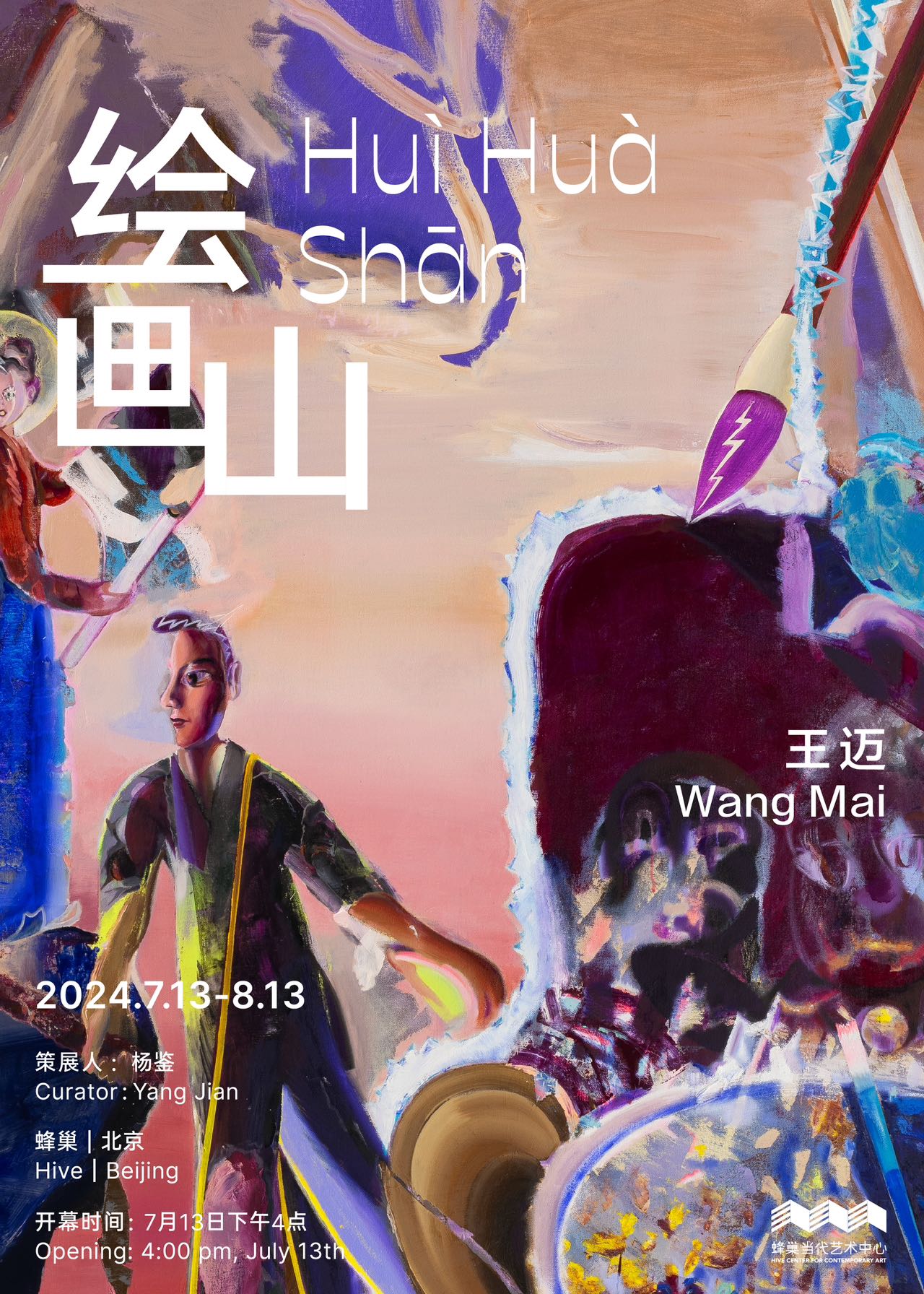展期 Period:
2024.7.13—2024.8.13
艺术家 Artist:
策展人 Curator:
地点 Venue:
蜂巢当代艺术中心 Hive Center for Contemporary Art(北京)
前言 Introduction:
蜂巢|北京荣幸地宣布将于2024年7月13日在主展厅A厅推出艺术家王迈的最新个展“绘画山Huì Huà Shān”。作为对艺术家王迈近两年的观念性绘画创作的整体呈现,本次展览由杨鉴策划,将持续至2024年8月13日。
“绘画山”是近年来王迈用以描述自身艺术实践及绘画理解的关键词。相较于仰仗着现实空间的装置与雕塑,绘画顽固得就像是一种无法被“建模”但具有深邃时空观的存在,绘画性及其传统作为一种现实物,被识别为一种直觉和感性的载体,而这里的“山”则暗指某种攀登和穷极本质的过程,一种西西弗斯式样的求索原型世界的努力,其中伴随着王迈对以往依赖理性、知识与信息的创作方式的自省与回望。作为“圆明园”艺术家群落的重要参与者,王迈自上世纪九十年代初期便开始建立其“整体艺术”的创作构架,横跨绘画、雕塑、诗歌、装置、行为艺术等多个领域。在近年的创作中,他将此前创作模式中对于现实状态的即时反应,转化成为当下这种对于状态的梳理和聚集。这种有趣却又生发自然的过程就像攀登途中最吸引人的往往不会是紧盯脚下的崎路,而是不时回望已然越过的山岭与蜿蜒峰峦,从而激发继续攀登的兴趣和欲望。
至少是从千禧年开始,王迈逐步且系统地构筑起一套标志性的观念语法体系,旨在挑战艺术媒介与语言间的静态格局,并制造某种流动中标注不同时代的视觉锚点。王迈从现代主义的土壤中汲取了以社会性眼光捕捉现成物与视觉素材的传统,并借助充满时代性、转化性和脆弱性的现实素材来瓦解它们此前所指代的权威。这一解构过程不止纯粹的批判与反思,还指向拆解与重构的开放姿态。以一种悬置的身临其境和充满戏谑、挑衅的作品,王迈质疑了社会对现实物的依赖与人们对物质的迷恋,并就其如何赋予并统治了我们现实生活中的时代感与意义感展开了讨论。
作为最早探讨当代中国消费主义现象的艺术家之一,王迈在对自我身份与美术史资源的再度检索中,选择以一种园林造景般的绘画模式重提消费话题,以形成更多剖面的方法来呈现当代消费图志的多样性、历史感及其裹挟人们现实生活的复杂感。有趣的是,王迈选择了一种复古的论调和画面特质,荧光色、电子屏等他曾使用过的元素被重新翻起并自我挪用,勾连起自身的美术史线索,像是以浓缩的表达去阐述消费与欲望恒久不变的本质。在此基础上,作为参与到中国当代艺术宏大叙事的主流当中的艺术家,我们依然可以于恍惚间感受到存留于作品之中的政治属性,只不过部分变得暧昧的元素被挪用为一种怀旧的语言,并且与王迈戏谑般引入的波普艺术、商业拼贴画、卡通甚至宗教绘画杂糅在一起,变成某种怪异的混合物。在王迈的作品里,政治性的元素可能已经被确立为一种亲历而难以割舍的,令人厌倦但却趣味横生的视觉残余。
基于我们对于王迈的既有认知,本次展览的所有绘画作品亦可被想象为一个巨大的聚合的装置——绘画山。凝神观看,人们仿佛不知不觉步入山中,进入梦境。毫无疑问,对于绘画这座险峰王迈还在不断的攀登与建构当中,正如我们在王迈的作品当中常常看到的人们正热情的奔赴着不明的方向,或许,正是通过满怀激情、向未知方向毅然前行人物形象,王迈意在运用一种未明和未知的媒介,向观者深刻揭示一个微妙而深刻的悖论,即借由浑沌,才能清晰彰显这个当下时代的奥秘。
Hive Beijing is honoured to announce Wang Mai’s upcoming solo exhibition “Huì Huà Shān”, on view since 13 July 2024 in Hall A. This exhibition serves as a survey of Wang Mai’s conceptual paintings over the past few years. Curated by Yang Jian, this show will be on view until 13 August 2024.
“Huì huà shān”, the title of the exhibition, refers to Wang Mai’s description of his artistic practice and understanding of painting in recent years. As opposed to installation and sculpture that depend on physical space, “huì huà”, meaning painting and to paint, remains persistent as an entity that cannot be modelled but carries a profound sense of time and space, since painterliness and its tradition as an existing reality are recognised as a medium of intuition and sensibility. The “shān”, or mountain here, suggests a process of climbing and extreme endeavour, a Sisyphean effort to explore the archetypal world, followed by Wang’s self-examination and retrospection of his previous creative approach of reliance on rationality, knowledge, and information. An indispensable participant of the Yuanmingyuan Artists’ Village, since the early 1990s, Wang has been developing his creative structure of interdisciplinary art encompassing painting, sculpture, poetry, installation, performance art, and many other disciplines. In his recent practice, Wang transformed the immediate response to reality in his former creative approach into the organisation and collection of the state of affairs at present. This intriguing yet spontaneous process is similar to how the most fascinating part of a climb is often not fixating on the path below, but rather the occasional glance back at the mountain ranges and meandering peaks already crossed, thereby fueling the interest and desire to keep climbing.
Beginning around the turn of the century, Wang Mai has progressively and methodically established an emblematic system of conceptual grammar, with the intention of challenging the static structure of the art medium and language while creating a visual reference in the flux of symbolising the different eras. Wang Mai absorbs from the soil of modernism the legacy of capturing readymade objects and visual materials through a social approach, then utilises the contemporary, transformative, and fragile nature of these existing materials to dismantle the authority to which they previously referred. This process of deconstruction exceeds mere critique and reflection, it also indicates an openness to demolition and reconstruction. Through a suspenseful presence and parodic, provocative works, Wang confronts society’s reliance on existing objects and people’s obsession with materiality, and examines how they empower and dominate the sense of time and significance in our reality.
As one of the earliest artists to explore such a phenomenon in contemporary China, in re-examination of his identity and art historical resources, Wang Mai reintroduces the topic of consumerism in the form of landscape painting, in an attempt to create more facets to present the diversity of contemporary consumerism, its historical significance, and the complexity surrounding the realities of lives. Interestingly, Wang adopts a rather retro tone and texture, in which fluorescent colours, electronic screens, and other elements he once embraced are revived and re-appropriated, connecting to the threads of his development of practice, and elaborating on the eternal nature of consumption and desire through encapsulation. In this way, we can still perceive indistinctly the lingering political references in his work, as he participates in the grand narrative of mainstream contemporary Chinese art; only that some ambiguous features have been appropriated into a nostalgic language and mixed with elements of pop art, commercial collage, cartoon, and even religious painting that Wang humorously introduces into his work, becoming some bizarre and grotesque composite. In the artist’s work, the political elements may have been established as a personal and inextricable, wearisome yet playful visual residue.
Now, with our existing knowledge of Wang Mai, we can boldly imagine all the paintings in this exhibition as a massive cohesive installation. Gazing intently, we step into the mountains and enter the realm of dreams unconsciously. Without a doubt, Wang is still climbing and building up this treacherous peak that is painting, an unknown direction his figures enthusiastically run towards just as we often perceive in the works. Perhaps, it is through the passionate and resolute figures that Wang, using the medium of the unknown and unspecified, unveils to the viewer a subtle yet profound paradox, that is, only through chaos can the mysteries of the current time be clearly revealed.

